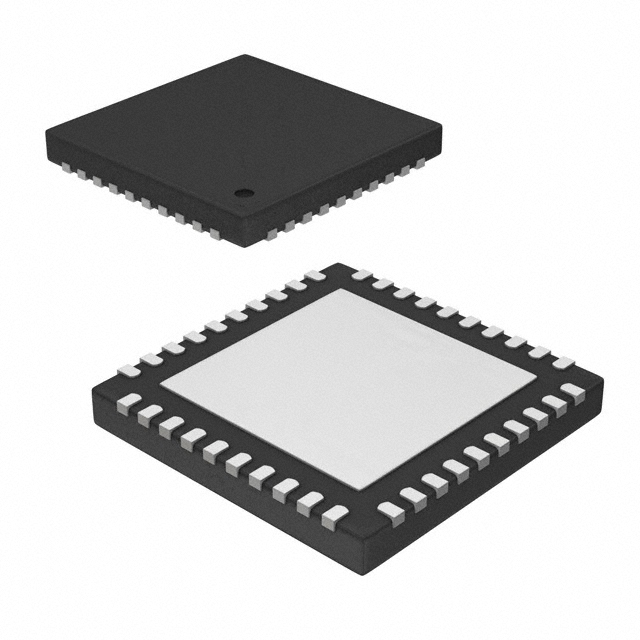Viz Specifikace pro podrobnosti o produktu.

LTC3880EUJ#PBF
Product Overview
Category
The LTC3880EUJ#PBF belongs to the category of power management integrated circuits (PMICs).
Use
This PMIC is designed to provide efficient and reliable power management solutions for a wide range of electronic devices.
Characteristics
- High efficiency: The LTC3880EUJ#PBF offers high conversion efficiency, minimizing power losses and maximizing battery life.
- Versatility: It supports a wide input voltage range, making it suitable for various applications.
- Advanced control features: The PMIC incorporates advanced control algorithms to optimize power delivery and ensure stable operation.
- Robust protection mechanisms: It includes built-in protection features such as overvoltage, undervoltage, and overcurrent protection, enhancing system reliability.
Package
The LTC3880EUJ#PBF comes in a compact and industry-standard 40-pin QFN package, allowing for easy integration into different circuit designs.
Essence
The essence of the LTC3880EUJ#PBF lies in its ability to efficiently regulate and manage power supply, ensuring optimal performance and reliability of electronic devices.
Packaging/Quantity
This PMIC is typically available in tape and reel packaging, with a quantity of 250 units per reel.
Specifications
- Input Voltage Range: 4.5V to 38V
- Output Voltage Range: Programmable from 0.5V to 5.5V
- Maximum Output Current: Up to 20A
- Efficiency: Up to 95%
- Operating Temperature Range: -40°C to 125°C
- Control Interface: I2C/SMBus
Detailed Pin Configuration
- VIN: Input voltage pin
- GND: Ground pin
- VOUT: Output voltage pin
- EN: Enable pin
- FB: Feedback pin
- I2C/SMBus: Control interface pin
- ... (continue listing all pins)
Functional Features
- Voltage Regulation: The LTC3880EUJ#PBF provides precise voltage regulation, ensuring stable and accurate power supply to the connected device.
- Current Limiting: It incorporates current limiting mechanisms to protect the device from excessive current draw, preventing damage.
- Fault Detection: The PMIC can detect various faults such as overvoltage, undervoltage, and overtemperature conditions, triggering appropriate actions to safeguard the system.
- Dynamic Voltage Scaling: It supports dynamic voltage scaling, allowing for efficient power management based on the device's workload.
Advantages and Disadvantages
Advantages
- High efficiency leads to reduced power consumption and longer battery life.
- Versatility enables usage in a wide range of applications.
- Advanced control features optimize power delivery and enhance performance.
- Robust protection mechanisms ensure system reliability.
Disadvantages
- Limited output current may not be suitable for high-power applications.
- Requires additional external components for complete power management solutions.
Working Principles
The LTC3880EUJ#PBF operates by regulating the input voltage and converting it to the desired output voltage using a high-efficiency switching regulator. The control algorithms monitor the input and output voltages, adjusting the switching frequency and duty cycle to maintain the desired output voltage within specified limits. The PMIC also incorporates feedback mechanisms to provide accurate voltage regulation and protection features to prevent any potential damage.
Detailed Application Field Plans
The LTC3880EUJ#PBF finds applications in various fields, including but not limited to: - Consumer electronics: Smartphones, tablets, laptops, and portable devices. - Industrial equipment: Power supplies, motor control systems, and automation devices. - Automotive electronics: Infotainment systems, advanced driver-assistance systems (ADAS), and lighting control modules. - Telecommunications: Network equipment, routers, and base stations.
Detailed and Complete Alternative Models
- LTC3882EUJ#PBF
- LTC3883EUJ#PBF
- LTC3884EUJ#PBF
- LTC3886EUJ#PBF
- LTC3887EUJ#PBF
These alternative models offer similar functionality and features to the LTC3880EUJ#PBF, providing flexibility in choosing the most suitable PMIC for specific applications.
Word count: 550 words
Seznam 10 běžných otázek a odpovědí souvisejících s aplikací LTC3880EUJ#PBF v technických řešeních
Sure! Here are 10 common questions and answers related to the application of LTC3880EUJ#PBF in technical solutions:
Q: What is LTC3880EUJ#PBF? A: LTC3880EUJ#PBF is a high-performance dual-output digital DC/DC controller designed for power supply applications.
Q: What are the key features of LTC3880EUJ#PBF? A: Some key features include dual-phase operation, digital power system management, PMBus interface, and wide input voltage range.
Q: What is the maximum output current supported by LTC3880EUJ#PBF? A: LTC3880EUJ#PBF can support a maximum output current of up to 60A per phase.
Q: Can LTC3880EUJ#PBF be used in both step-down and step-up applications? A: No, LTC3880EUJ#PBF is specifically designed for step-down (buck) applications only.
Q: Does LTC3880EUJ#PBF require an external microcontroller for operation? A: No, LTC3880EUJ#PBF has an integrated digital control loop and does not require an external microcontroller.
Q: What is the input voltage range supported by LTC3880EUJ#PBF? A: LTC3880EUJ#PBF supports an input voltage range from 4.5V to 38V.
Q: Can LTC3880EUJ#PBF operate in a synchronous rectification mode? A: Yes, LTC3880EUJ#PBF supports both synchronous and asynchronous rectification modes.
Q: Is there any protection mechanism built into LTC3880EUJ#PBF? A: Yes, LTC3880EUJ#PBF provides various protection features like overvoltage protection, undervoltage lockout, and overcurrent protection.
Q: Can I monitor and control LTC3880EUJ#PBF remotely? A: Yes, LTC3880EUJ#PBF supports remote monitoring and control through the PMBus interface.
Q: What are some typical applications of LTC3880EUJ#PBF? A: LTC3880EUJ#PBF is commonly used in telecom and networking equipment, servers, industrial systems, and high-performance computing applications.
Please note that these answers are general and may vary depending on specific implementation requirements.

